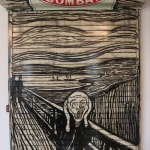Atul Dodiya
Taj Mahal Bombay, 2013
Exterior: Enamel paint and brass letters on motorized galvanized roller shutter with iron hooks; Interior: Oil, acrylic with marble dust and oil stick on canvas
Original Sizes Available:
Exterior: 274 x 183 cm; Interior: 221 x 158 cm
Exterior: 274 x 183 cm; Interior: 221 x 158 cm
Sold
Atul Dodiya is one of the most prominent figures of contemporary Indian art. He melds the iconography of both Eastern and Western cultures through film, popular culture, and literature—doing so...
Atul Dodiya is one of the most prominent figures of contemporary Indian art. He melds the iconography of both Eastern and Western cultures through film, popular culture, and literature—doing so in the form of installation and painting. Dodiya’s works are deeply personal as he reflects on his own narratives with reference to the history of art and that of his home country, India.
The shutter doors bring the commonly seen protective Bombay shop fronts into the contemporary art genre. On the shutter of Taj Mahal Bombay (26/11) appears a street art version of Edvard Munch's The Scream, incongruously topped with the logo of Bombay's Taj Mahal Palace Hotel, lettered in 19th-century, Victorian era characters. Within the colonial typography of the Taj Mahal Palace hotel resounds Edvard Munch's primordial scream, the shutter door was a response to the terror attack of 26/11. Behind the shutter, a man sits in a yoga pose that opens his chest. He is Krishna from the tale of "Krishna Swallows a Forest Fire and Saves the Villagers." The inhalation circumscribes and defines a whole world, including a boat with full sails skimming the ocean (near his feet).
On November 26, 2008, India experienced its own version of "9/11." Pakistani terrorists arrived by sea and launched attacks on various significant locations in Mumbai, most notably the grand and majestic Taj Mahal Palace Hotel, which left a lasting impression due to the extensive media coverage. The attacks lasted for three days, resulting in the deaths of over 150 people and leaving several hundred others seriously wounded.
By invoking Edvard Munch's image as a public response to terrorism, Dodiya employs it as a universal symbol of horror and grief. Dodiya's artistry shines through his dual-sided storytelling on the shutters, urging viewers to engage with emotional narratives, showcasing his skill in painting on metal and canvas.
Highly original, Dodiya's works contain layers of meaning that can be stripped metaphorically or by means of the remote control of the mechanical shutter. They can be read half-closed or open as well as fully seeing one image or the other.
The shutter doors bring the commonly seen protective Bombay shop fronts into the contemporary art genre. On the shutter of Taj Mahal Bombay (26/11) appears a street art version of Edvard Munch's The Scream, incongruously topped with the logo of Bombay's Taj Mahal Palace Hotel, lettered in 19th-century, Victorian era characters. Within the colonial typography of the Taj Mahal Palace hotel resounds Edvard Munch's primordial scream, the shutter door was a response to the terror attack of 26/11. Behind the shutter, a man sits in a yoga pose that opens his chest. He is Krishna from the tale of "Krishna Swallows a Forest Fire and Saves the Villagers." The inhalation circumscribes and defines a whole world, including a boat with full sails skimming the ocean (near his feet).
On November 26, 2008, India experienced its own version of "9/11." Pakistani terrorists arrived by sea and launched attacks on various significant locations in Mumbai, most notably the grand and majestic Taj Mahal Palace Hotel, which left a lasting impression due to the extensive media coverage. The attacks lasted for three days, resulting in the deaths of over 150 people and leaving several hundred others seriously wounded.
By invoking Edvard Munch's image as a public response to terrorism, Dodiya employs it as a universal symbol of horror and grief. Dodiya's artistry shines through his dual-sided storytelling on the shutters, urging viewers to engage with emotional narratives, showcasing his skill in painting on metal and canvas.
Highly original, Dodiya's works contain layers of meaning that can be stripped metaphorically or by means of the remote control of the mechanical shutter. They can be read half-closed or open as well as fully seeing one image or the other.
Exhibitions
Duplicator’s Dilemna (2013) 2014 - Group Show March ArtWalk 2014 ART_BASEL_HK_201415
of
15



